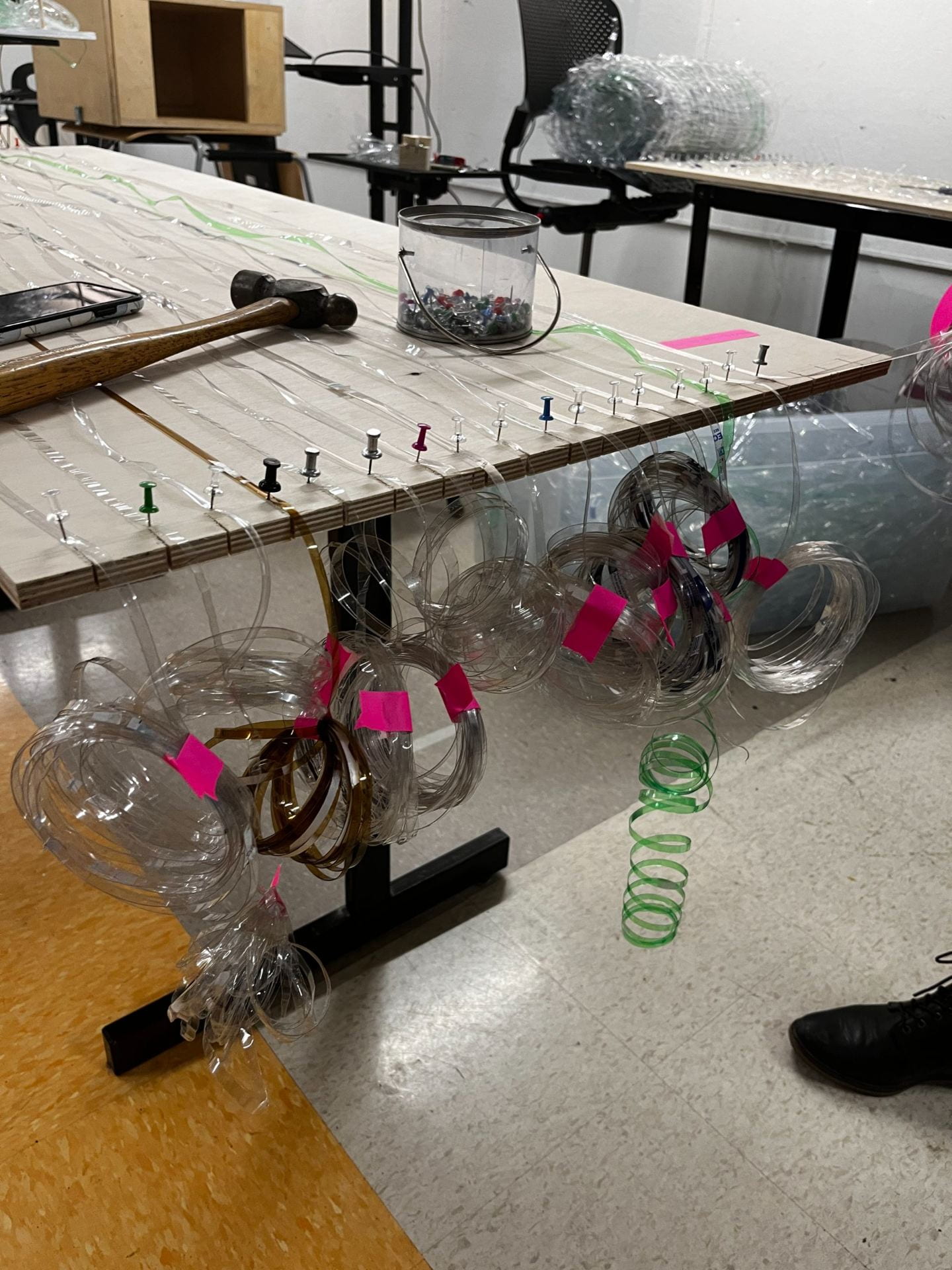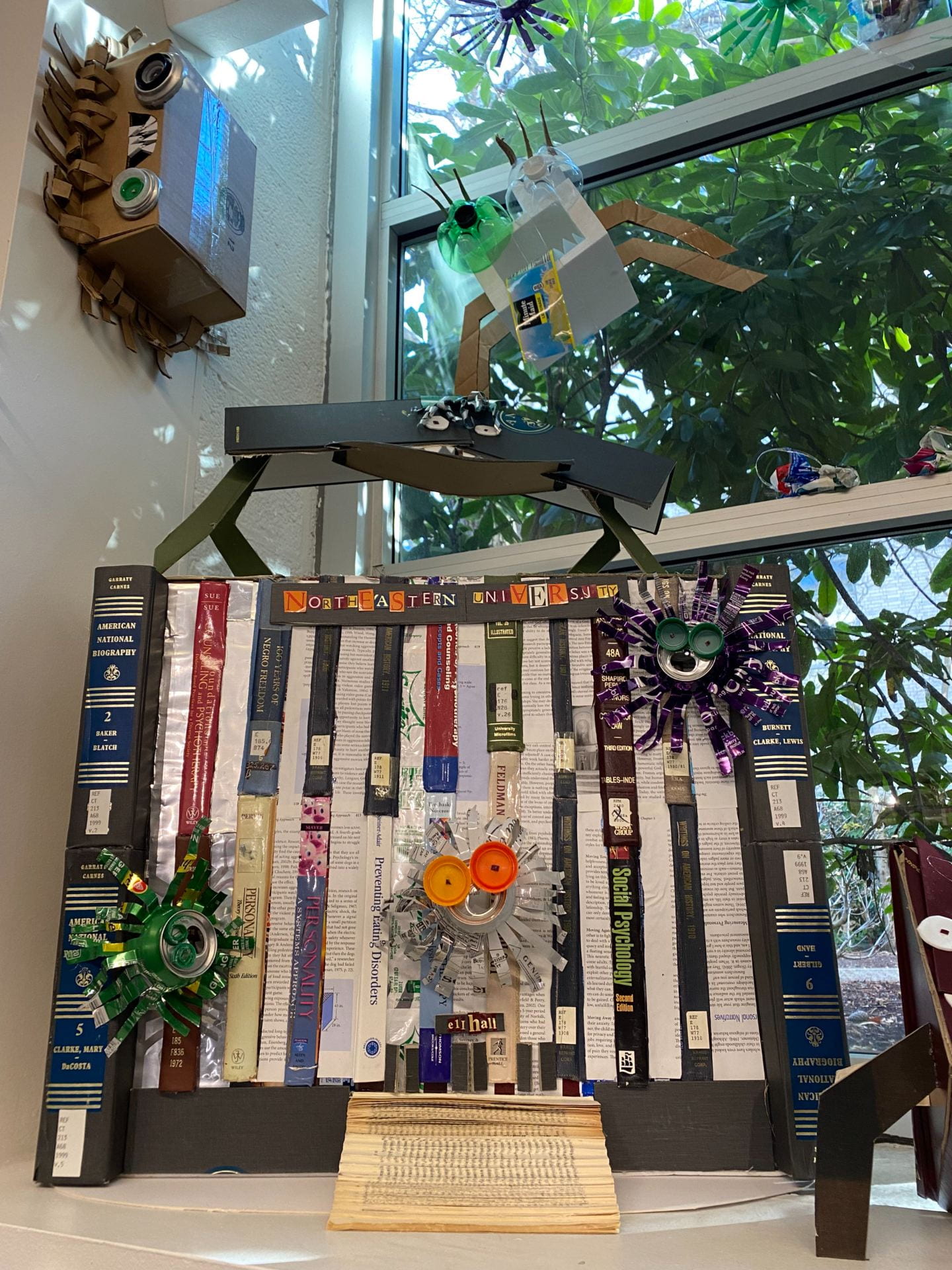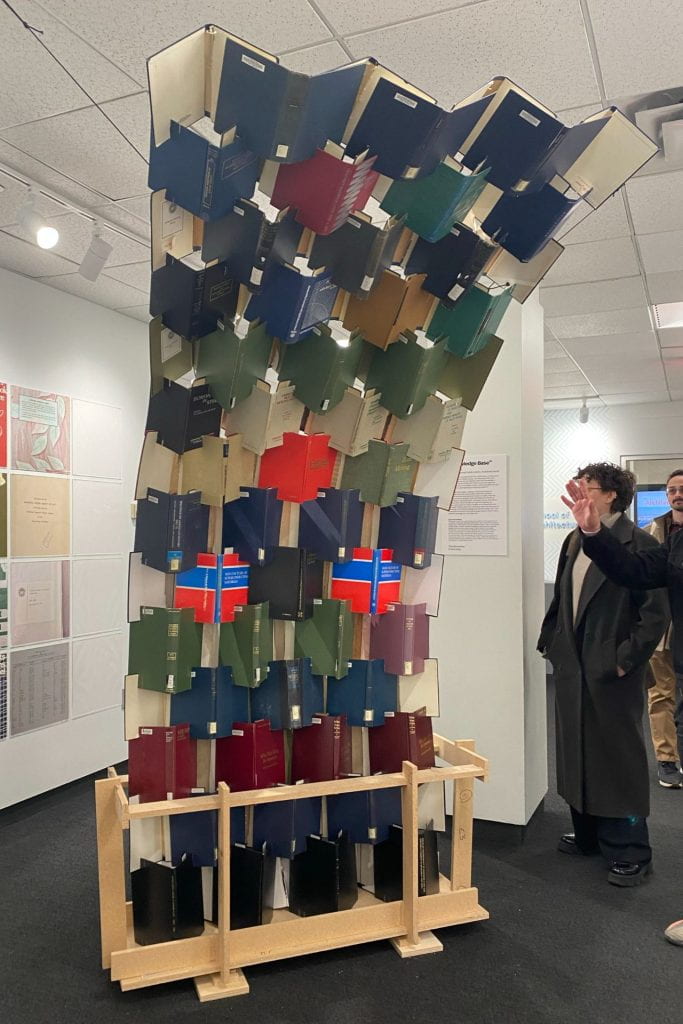Something Old, Something New: NU Architecture Class Displays Installations Made from Recycled Materials

This semester, students in ARCH 5115 The Circular Installation Studio were presented with a unique final project challenge: to create an installation using only recycled materials, many of which came directly from the university.
“The last two times I taught an installation studio, it was working with biodegradable homemade materials,” says Hale, Associate Teaching Professor for the course. “But this time I felt so aware of the waste problem. Why don’t we, as architecture students, start becoming more aware of waste and how it can be integrated into [our] practices to avoid using virgin material when it’s not necessary? It’s been an interesting exploration.”
Students were able to work on projects individually or in pairs, becoming fully immersed within each step of the creative process. “I like to work with installation as a topic in an architectural studio because it enables students to experience the architectural design process in a semester, at a small scale that they can achieve,” Hale explains. “The students are all having that experience of envisioning an idea, going through a design process, and then putting it out into the world on a site and seeing how people react to it. That’s valuable education for architecture students.”
Jake Okrent and Avery Gilloren, “156”
Students Jake Okrent and Avery Gilloren found inspiration in weaving practices when developing their plastic bottle project, “156”. According to Okrent and Gilloren, the average U.S. citizen disposes 156 bottles annually. “The idea was to take 156 plastic bottles and weave them together into a long sheet,” Okrent explains.
To do this, Okrent and Gilloren sliced plastic bottles into strips using a homemade bottle cutting device. The bottoms of the plastic bottles are cut away, leaving a clean edge where the bottle is then fed through a narrow slot in a block of wood. A blade installed within the block slices the bottle as it is rotated through the device.
The result is a durable, yet relatively flexible, spiral of plastic material that is ready to be woven into sheets. Okrent and Gilloren made five sheets using their reclaimed plastic material, each consisting of exactly 156 bottles. Both students come from a family of five, and they sought to visualize the plastic bottle consumption of this family size within their project. Each sheet represents the annual plastic bottle consumption of one individual.
Okrent and Gilloren cut about 900 bottles in total for the project, collected from the Northeastern recycling center in just three days. Once completed, the woven sheets were draped across the buttresses in the Snell Library West Entrance Plaza.
“During the day, we expect that it’s going to catch some sunlight and look pretty,” Gilloren says. “But we’re especially looking forward to seeing how it looks at night. The library has lights that overhang down and we’re looking forward to seeing what the shadows look like. It’ll be something that people can walk under and experience.”
With tighter weaves, plastic bottles could also find a second life in everything from hammocks to the seats of lawn chairs. Okrent and Gilloren are excited by the range of additional uses their woven plastic material could serve.



Joana Tourinho, “Blunt Form”
Student Joana Tourinho worked with a variety of recycled materials from the university, including paper, glass, and polyethylene bags, while also experimenting with the creation of new material applications and distinctive presentation techniques.
Tourinho channeled the elements into two main project components: hanging installations of plastic and glass and hanging central structures composed primarily of paper pulp.
“The whole idea behind the project itself is that I’m inflicting violence on these materials, then trying to form something from the remains of it,” Tourinho explains. “It’s a dialogue between what I’m doing and the materials’ autonomy. If it wants to stay up it will. And then whatever the way that it wants to be contained, it will also.”
For the glass installations, Tourinho started by shattering glass bottles. “They all created these different shapes,” Tourinho describes. “I wanted to be able to trap that, so I sealed them within plastic.” The shattered shapes of the glass are held in pockets between long plastic sheets, which were heated to create a seal. When illuminated, the result is a striking blend of color, angles, and light. Tourinho also experimented with the creation of paper pulp by shredding paper, submerging it in hot water, and blending the two together. “I’m calling it ‘formal experimentation,’” Tourinho explains. A variety of techniques were used to explore different forms for the pulp, before Tourinho decided to plaster the pulp across the top of boulder-like structures made from plastic and paper, where it was then left to dry and harden for later removal and installation. “Blunt Form” was on display in Kariotis Hall, in the connecting corridor leading to Dockser Hall. The glass installations were hung from the windows, playing with shadow and light. Two paper pulp structures hung from the ceiling, seemingly floating in midair and gently rotating through space.
Tourinho hopes the installation will create a meditative, quiet space for students to reflect.



Nichole Alvarez, “Almost Made of Trash”
Student Nichole Alvarez takes a playful approach to addressing the problem of waste. “Almost Made of Trash” features models of recognizable buildings across Northeastern’s Boston campus, made from the recycled materials of the University. However, these buildings are also plagued by a threat: trash monsters. These imaginative characters come in all sorts of shapes, sizes, colors, materials, and personalities. Cardboard packages, Styrofoam, plastic bottles, aluminum cans, decommissioned library books and textbooks, discarded tree tags, and other assorted campus materials were all used within this project. Alvarez says it was important that the finalized trash monsters maintain their sense of “trash-ness” – a reminder of their origins as waste. “Many of the monsters are huge compared to the buildings, that’s part of the fiction of it,” Alvarez explains. The looming trash monsters serve as a reminder to the Northeastern community, to be conscious of how our consumption of single-use materials can overtake the places we consider home, unless we continue to invest time, energy, and resources into waste reduction programs, such as those offered through the university.
Alvarez’s project is also interactive, further engaging students and members of the Northeastern community within topics of waste and materials recycling. “Missing” signs call viewers to return can monsters, hidden throughout the tunnels under campus, to the installation site. A QR code next to the installation also takes viewers to a website Alvarez created, where they can find information about the project as well as a “Meet the Stars” section introducing each of the monsters.
“Almost Made of Trash” was on display in Curry Student Center, across from the bookstore.



Sterling Yun, “Knowledge Base”
Student Sterling Yun was inspired to create his installation after seeing the hardcovers from books being disposed of by the library. “I saw a bunch of them, and it got me thinking about the process of knowledge creation in libraries, how libraries pick what books to add and remove as they maintain their collection,” Yun explains. “And I started thinking about ways I could externalize those questions and create an installation that makes people think about the same questions I was thinking about.”
Yun began by experimenting with stacking the books in different ways, before deciding on a model in which grooves are cut into the hardcovers, then the hardcovers are slid together to create a secure joint. Dozens of books were connected through this system to create a stable form. But with the gentle curve of the installation, Yun also conveys a sense of dynamism and flexibility. “In terms of the form, I think it was a good opportunity to experiment with different kinds of materials and forms,” Yun says. “Tying back to the idea of waste, I think it raises questions of obsolescence, in terms of material use but also in terms of knowledge.”
Yun emphasizes that while a book may be thrown away, the knowledge contained within it is not a “waste”. Disposed materials may become a source of inspiration for new projects, like the installations, and in the same way, our existing knowledge base may also contain sources of inspiration, and what’s old may become new again. “Knowledge Base” is on display on the School of Architecture Gallery within Ryder Hall, along with additional information about the project and the building process. The installation will remain in the Gallery through early March.
On December 9th, students presented their installations on-location to classmates, friends, members of the Facilities Department who assisted in the material collection, and a panel of critics. The installations were displayed across campus to showcase student creativity and highlight how discarded material can be repurposed in innovative ways.



See the full list of student installation projects from Mary Hale’s Option Studio class below:
Nichole Alvarez, “Almost Made of Trash”
Isik Birkent, “The Unseen”
Valentina CantIIlana, “Peanut”
Alice Clements, “Hurdle”
Omarlyn Martinez, “MAKE SOME noise”
Aidan Mayer, “Whip Stitch: The Human Side of Fast Fashion”
Jake Okrent & Avery Gilloren, “156”
Shannon Rooney, “REVIVE”
Daniel Safranchik, “Concentric”
Joana Tourinho, “Blunt Form”
Robert Walshe, “A Trace of Wind”
Karissa Xu and Evelyn Tan, “Parasitism”
Sterling Yun, “Knowledge Base” *On Display Through March 2023: School of Architecture Gallery, in front of 151 Ryer Hall*
Special thanks to Sue Higgins, Northeastern’s Associate Director for Materials and Recycling and Cashbee Calderon, Zone Manager, for collaborating with this studio and providing the majority of the waste materials from which projects are constructed; Thomas Vannatter, Public Arts Manager, for his feedback and commitment to showcasing student work on campus; Patrick Kana, CAMD Shop Manager, for advising students working with wood; and Dan Adams, Director of the School of Architecture, for supporting the studio.
Written by Daria Healey, December 2022
Photos by Daria Healey, Elana Lane, Joana Tourinho, and Sterling Yun.
